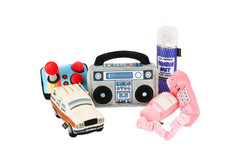Putting your new fur baby into a crate or cage may seem cruel to some pet parents. However, crate training does have its benefits.
Dogs are denning animals and feel secure and comfortable in a smaller area. Add a comfy bed and his favorite toy, and you've now created a haven for your puppy to escape the hustle and bustle of a busy household.
Most of us cannot spend every moment watching a puppy. A crate is a safe place for your new pet when you can't be keeping watch or when the household is chaotic (such as family gatherings, parties, etc.).
Lastly, all puppies and dogs at some point in their lives will need to go into a crate (traveling, vet visits, and overnight stays). Isn't it better to already have your pup accustomed to the idea of being confined, before it is a necessary task?
In this post, we've dug up 5 tips to consider when crate training a puppy. These work!
Tip # 1 - Get the Right Fit

For a crate to be practical, especially for potty training, it has to be the right fit for your canine. You may think the bigger, the better. The problem with this adage is your puppy will most likely use the back corner of the crate to do his business, then move to the front to sleep.
A properly fitting crate should allow enough room for your puppy to stand up, turn around, and lie back down again. If your puppy is a bigger breed, like a Golden Retriever, there are specially made crates that come with dividers which can be moved as your pup grows.
A note to the wise, avoid soft-sided crates. These are perfect for traveling but can be easily destroyed by a power-chewer.
Tip # 2 - Make it Fun
Taking a puppy, locking him in a crate and walking away can make the whole experience very traumatic for your new fur baby. Experts recommend placing the crate in an area where you spend the most time. This could be a bedroom, kitchen, den or living room.
After you place the crate, let your puppy explore it with the door open. Puppies are curious, so he will most likely wander in and out of it and give it a good sniff-over. Be sure to praise and reward your pup each time he goes into the crate on his own.
Making the crate a fun experience will help avoid any anxiety your puppy may feel towards this strange new object.
Tip # 3 - Make it Comfortable
No one wants to spend time in an area that is uncomfortable; your pup is the same. When you are setting up the crate, use a soft blanket or special pad for added comfort. Make sure whatever type of bedding you use is chew proof, to avoid a potential choking hazard.
Add in some safe toys to give your dog something to do while in the crate. These should also be chew proof. Tough toys like the Kong products offer the benefit of a hole where you can add bits of dry kibble or peanut butter. What a treat!
Tip # 4 - Use Food as Positive Reinforcement

When you are first getting your puppy accustomed to the crate, use positive reinforcement in the form of treats or food; bits of cooked chicken, apple, or carrots work well.
You can also put the food inside the crate as a way to lure your puppy into the kennel. This non-threatening method will reduce any undue stress that may arise.
Tip # 5 - Never Use the Crate as Punishment
Since we want it to be associated with happy, never use it as a source of punishment. It may be tempting to put the puppy "away" after he has misbehaved, but we have to remember that all puppies will get into stuff at some point. It's up to us to be vigilant.
You will also want to be aware of how long you keep your puppy in the crate at one time. Generally speaking, puppies can hold their bladder one hour for every month of age. So an eight-week old puppy could potentially hold it for two hours.
Remember, small breeds have tinier bladders and may have to go more often. Your pup will also have to eliminate right after sleep and a meal.
Crate Training Doesn't Have to Be a Nightmare
If you're on the fence about crate training your puppy, just know that it doesn't have to be a nightmare. Follow these tips, be patient and give your puppy plenty of positive reinforcement and you'll soon be on the crate training path of success.





